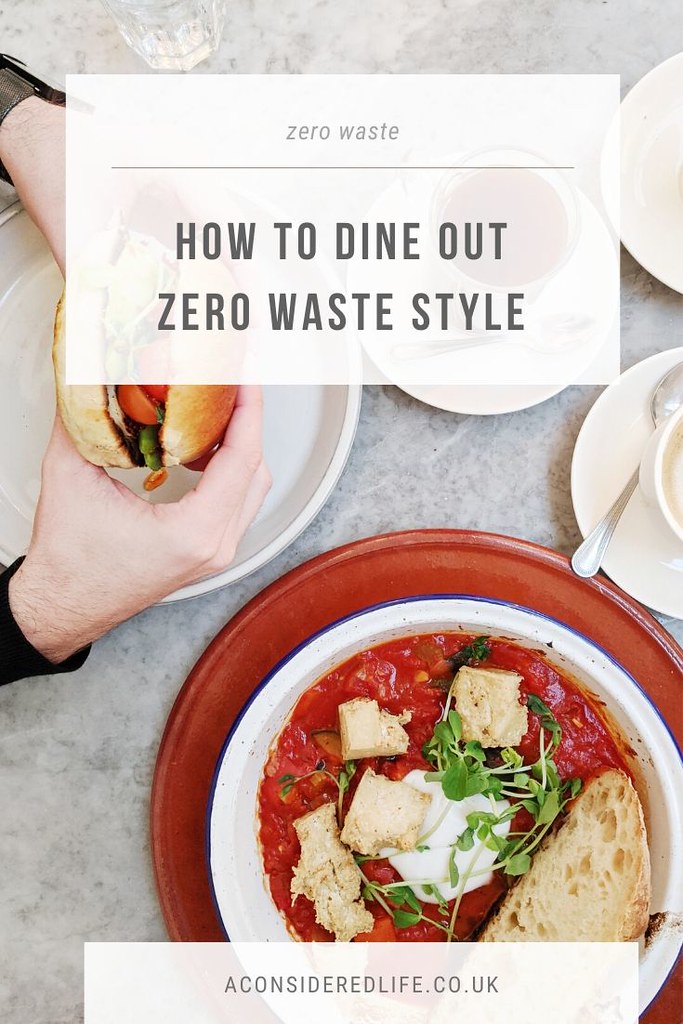
Minimising waste in the kitchen is relatively easy to stay on top of once you've adopted a more sustainable diet, learned some low waste shopping habits, and started composting leftovers. It's much more difficult to do when eating out.
Dining out is something I do regularly with my partner and our friends. It's a huge part of our social lives but it's also the area I need to most improve on when it comes to reducing my waste. The waste caused by single-use utensils, disposable napkins, and leftover food quickly piles up but there are ways to avoid it.
Choose Carefully
Try to choose places that deal with their waste responsibly such as giving unsold food to charity, composting leftovers, avoiding disposables when reusables can be supplied, etc. Small independent or family run businesses and those that source locally grown ingredients are your best option. They're also more likely to implement changes (like replacing single-use disposables with reusables) if you request them.
In sit-down restaurants it's easier to avoid waste. They have proper plates and bowls, reusable cutlery, and often (but not always) cloth napkins. What you might not be able to figure out is what the restaurant does with its leftovers.
Street food makes avoiding waste a lot trickier. I have noticed an increase in vendors providing compostable plates and cutlery although I'm not convinced these compostable items are actually being composted. If separate bins aren't provided, it's mostly all being sent to landfill. I prefer to take my own containers and cutlery when I know I'll be eating out.
Cafes, bakeries, sandwich shops, and similar fast food places may offer the option of skipping the packaging altogether and using your own container instead. It does require you to remember to bring your own cup and lunch box, which can be a little inconvenient at times.
A useful idea is to remember a couple of places you can go when you're hungry that provide low waste options, whether that's unpackaged snacks you can grab to go in your own container or quick food you can order to eat-in.
Dine In
One way to skip all of the single-use plastics and disposables is to dine in instead of taking your order to go. It's a really simple way to eliminate waste created from the extra packaging you typically get when ordering pre-made food. If you find there's often leftovers, order small portions or take a suitable container to take anything left over away with you. This is a great solution if you're getting dinner with friends but if you're grabbing food on your lunch break, you won't always have time to sit in to eat. Bear that in mind and either give yourself more time or bring your own utensils.
Bring Your Own
If it's a food stall, market, or cafe you can sidestep a lot of waste by bringing your own container, cutlery, cup, and napkin. A few things worth having to hand is a water bottle and/or reusable cup, cutlery set, container (for serving food or storing leftovers), cloth napkin, and reusable straw. When I know I'm going to a market or food event, I'm very good at packaging my zero waste kit. It's when I'm caught off guard that I end up creating waste. If you find yourself in a situation where you have a napkin or compostable cup, take it home with you to compost.
Order Just Enough
Food waste is a huge issue and you'll only contribute to it if you order more food than you need. Order just enough to satisfy your hunger and bring your own container to take home any scraps you can compost at home. If there are leftovers, have a container to hand to box them up in instead of using disposable cartons. The same goes for water. Request tap water and drink it; don't let it get dumped down the drain.
Request No Disposables
When ordering drinks or food that may come with a straw, single-use cutlery, or extra napkin, request your order doesn't come with them. You need to ask when ordering otherwise you'll find yourself with something you didn't want that won't be given to someone else. I've been caught out plenty of times by assuming my drink won't be served with a straw and I'm always surprised (and annoyed with myself) when it does.
When it comes to dining out, there are some things that are simply out of your hands. There's only so much you can do to minimise the waste it creates. If you're ordering food a lot, it's worth learning about the places you dine at and what efforts they're putting in to reduce waste beyond the food they serve and what the serve it on. Switching to more eco-friendly establishments will have a big impact.
As with all areas of zero waste living, I make exceptions when it comes to dining out. There's a burger place near me that serves all their food wrapped in copious amounts of grease-proof (that no doubt ends up in the bin) but I continue to eat there because the food is delicious and it's an independent businesses I want to support.
Limit how many times a month you dine out, opt for sustainable and eco-friendly establishments, know where you can take your own resusables, and take any leftovers home - it all helps reduce your waste.

